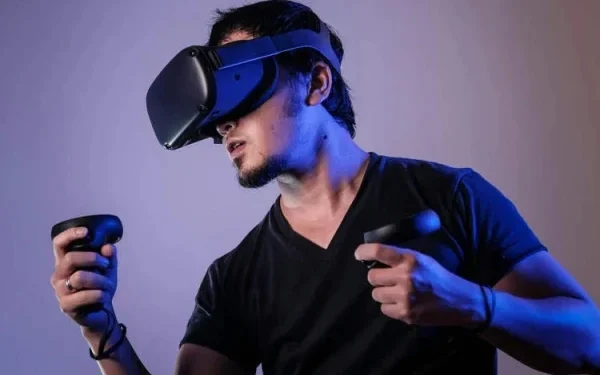In a surprising twist to the ongoing debate around the health impacts of video gaming, a new study from Japanese researchers suggests that playing certain types of virtual reality (VR) video games may actually improve eyesight, rather than harm it. This small-scale but promising research indicates that video games, often blamed for eye strain and visual fatigue, could become tools in the treatment of farsightedness (also known as hyperopia).
The Traditional View: Video Games and Vision Strain
For years, excessive screen time — especially among children and teens — has been linked to a range of eye problems. From digital eye strain and dry eyes to worsening myopia (nearsightedness), health professionals have long warned against the risks of prolonged exposure to digital screens.
Parents and educators have expressed concerns over kids spending hours in front of smartphones, tablets, and gaming consoles. Medical associations have recommended limits on screen time, and optometrists often advise taking frequent breaks using the 20-20-20 rule: every 20 minutes, look at something 20 feet away for at least 20 seconds.
However, the landscape of digital health is evolving, and emerging technologies like virtual reality and augmented reality are offering new ways to engage our vision — not just strain it.
New Research: A VR Game That Improves Eyesight
A team of Japanese researchers recently conducted a study to explore whether VR video games could actually benefit vision, particularly for those with farsightedness. In contrast to previous studies focused on eye fatigue, this research aimed to test the therapeutic potential of gaming environments that challenge the eyes to focus at different depths.
Study Design and Participants
The experiment involved 10 participants, a relatively small sample size, but enough to observe early trends. Over a six-week period, the participants played a simple virtual reality game designed to test their ability to focus on both near and far targets.
Game Mechanics: Training the Eye Muscles
The game was structured to train users’ focusing abilities. Players used their VR headset controllers to shoot at targets that appeared at various distances — some close-up, others far away. After successfully hitting a target, the player would automatically move backward, increasing the challenge of focusing correctly.
This repetitive gameplay created a scenario where the eyes had to constantly adjust focus between different distances, a process known as accommodation. For people with farsightedness, this type of visual activity is precisely what they struggle with — focusing on objects that are close.
Key Findings: Noticeable Improvement in Vision
Following the six-week gaming regimen, researchers assessed the visual performance of the participants. They found that even those who played the game every three days experienced notable improvements in their vision.
The results indicated that the visual accommodation ability of the participants — their capacity to switch focus between near and distant objects — had significantly improved. This improvement was not limited to in-game performance; participants also performed better in standard eye tests.
While the study’s small scale means that its findings are not yet conclusive, it opens the door to more comprehensive trials and experiments in the future.
Understanding Farsightedness: A Common Vision Problem
Farsightedness (hyperopia) is a condition in which a person can see distant objects clearly but has difficulty focusing on nearby objects. It is a common issue among older adults but can also affect children and young adults.
The condition occurs when the eyeball is too short or the cornea has too little curvature, causing light to focus behind the retina instead of directly on it. As a result, close-up tasks like reading or working on a computer can become difficult and lead to eye strain.
Traditional Treatments
Historically, hyperopia has been treated using:
- Prescription eyeglasses
- Contact lenses
- Laser eye surgery (LASIK)
- Vision therapy (for children)
The idea of using video games as a vision therapy tool is still relatively new but is gaining interest due to the increasing accessibility of VR technology.
The Role of Virtual Reality in Vision Therapy
Virtual reality provides an immersive environment where visual experiences can be precisely controlled and customized. Unlike traditional video games, VR allows players to experience depth perception, 3D motion, and realistic spatial navigation, making it an ideal medium for eye-training exercises.
The game used in the study essentially functioned like a digital version of physical eye therapy, training the ciliary muscles responsible for changing the shape of the lens in the eye to focus at various distances.
Why VR Works for Vision Training
- Controlled Visual Stimuli: VR games can present targets at exact distances and control the speed, size, and frequency of those targets.
- Immersive Environment: Unlike regular screen-based games, VR games fully engage the eyes in a 3D space, mimicking real-world depth and distance perception.
- Engagement and Motivation: Games provide a fun and engaging platform for training, which can improve consistency and duration of therapy sessions.
Potential Applications and Future Research
Though the study is in its early stages, the findings suggest that VR games could be developed as therapeutic tools for people with mild to moderate hyperopia. Future applications may include:
- At-home vision therapy kits using affordable VR headsets.
- Customizable VR games tailored to specific visual impairments.
- Integration into optometrist-guided therapy programs.
The researchers plan to conduct larger clinical trials involving participants of varying age groups and degrees of hyperopia to validate the findings.
Expert Opinions: Encouraging but Preliminary
While the study has generated excitement, vision specialists and ophthalmologists urge caution. Dr. Naoko Tanaka, a vision science expert based in Tokyo, commented:
“These findings are promising and highlight the potential of gamified therapy, but it’s important to remember that VR use can also cause dizziness, nausea, and visual fatigue if not properly monitored. Larger, peer-reviewed studies are needed before making medical recommendations.”
In addition, experts recommend limiting VR usage to short intervals (20–30 minutes) and ensuring proper lighting, posture, and device calibration to prevent any negative effects.
The Bigger Picture: Rethinking the Role of Video Games in Health
This research is part of a growing body of work exploring how video games and immersive technologies can be used for health and wellness rather than being viewed solely as recreational tools.
Other areas where video games are being explored include:
- Stroke rehabilitation
- Cognitive training for seniors
- Mental health therapy (e.g., PTSD, anxiety)
- Motor skills training in children with developmental delays
As technology continues to evolve, the intersection of entertainment and medicine is becoming a fertile ground for innovation.
Conclusion: A New Frontier in Eye Care?
The Japanese study offers a glimmer of hope that virtual reality gaming could play a role in non-invasive treatment for farsightedness. While more research is required to confirm and expand upon these findings, the study marks a milestone in the exploration of digital therapeutics.
For now, players and parents alike may take comfort in the idea that — under the right circumstances — video games could do more than just entertain. They might just help us see the world a little more clearly.

























